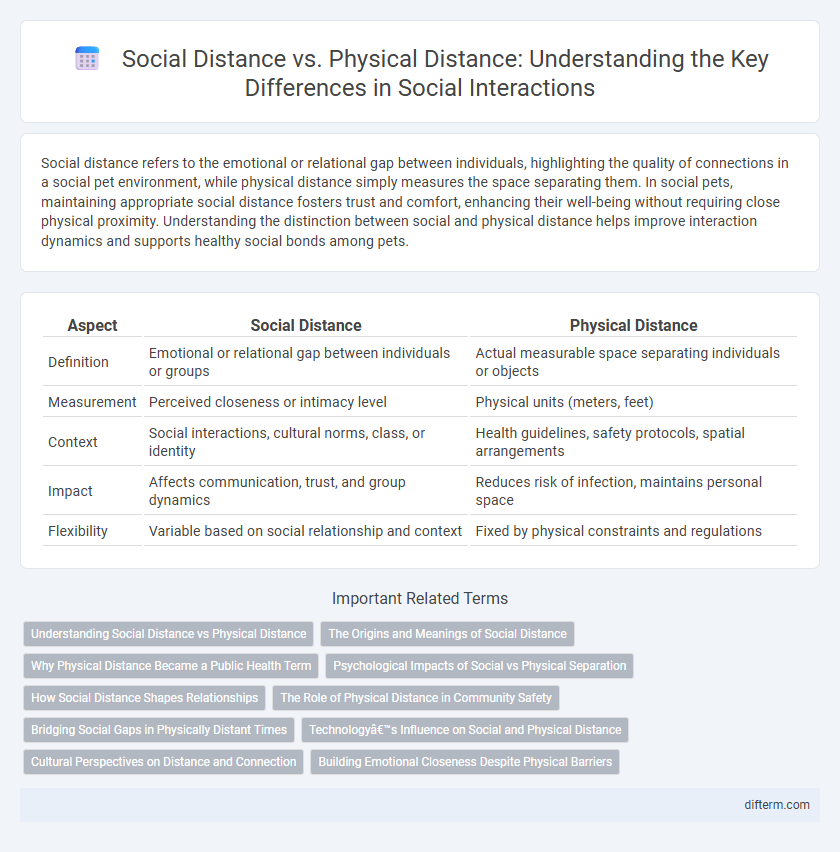Social distance refers to the emotional or relational gap between individuals, highlighting the quality of connections in a social pet environment, while physical distance simply measures the space separating them. In social pets, maintaining appropriate social distance fosters trust and comfort, enhancing their well-being without requiring close physical proximity. Understanding the distinction between social and physical distance helps improve interaction dynamics and supports healthy social bonds among pets.
Table of Comparison
| Aspect | Social Distance | Physical Distance |
|---|---|---|
| Definition | Emotional or relational gap between individuals or groups | Actual measurable space separating individuals or objects |
| Measurement | Perceived closeness or intimacy level | Physical units (meters, feet) |
| Context | Social interactions, cultural norms, class, or identity | Health guidelines, safety protocols, spatial arrangements |
| Impact | Affects communication, trust, and group dynamics | Reduces risk of infection, maintains personal space |
| Flexibility | Variable based on social relationship and context | Fixed by physical constraints and regulations |
Understanding Social Distance vs Physical Distance
Social distance refers to the emotional or relational space between individuals or groups, often influenced by cultural norms, social roles, and interpersonal trust, whereas physical distance pertains to the measurable spatial separation between people. Understanding the distinction between social and physical distance is crucial for effective communication, conflict resolution, and fostering inclusive environments. Research in social psychology highlights that reducing social distance can enhance cooperation and empathy, even when physical distance remains constant.
The Origins and Meanings of Social Distance
Social distance originally emerged in sociology to describe the extent of acceptance or rejection individuals or groups exhibit toward others based on factors like ethnicity, class, or social status, reflecting psychological and cultural boundaries rather than mere physical space. It represents relational gaps that influence social interactions, inclusion, and exclusion within communities, contrasted with physical distance, which pertains solely to measurable spatial separation. Understanding social distance clarifies issues in social cohesion and stigma by highlighting how perceived differences shape interpersonal and group dynamics beyond physical proximity.
Why Physical Distance Became a Public Health Term
Physical distance emerged as a crucial public health term during the COVID-19 pandemic to emphasize reducing virus transmission by maintaining space between individuals. Unlike social distance, which implies emotional or social separation, physical distance focuses on the measurable spatial gap required to minimize contact and airborne spread. Public health agencies, including the CDC and WHO, standardized physical distancing guidelines to protect communities and healthcare systems globally.
Psychological Impacts of Social vs Physical Separation
Social distance, referring to emotional or relational disconnection, often leads to feelings of loneliness, anxiety, and depression, which profoundly impact mental health. Physical distance, while reducing direct contact, does not inherently cause emotional detachment if communication channels remain open and meaningful. Understanding the differentiation between social and physical separation is crucial in addressing psychological well-being during times of enforced isolation.
How Social Distance Shapes Relationships
Social distance, defined by emotional and psychological separation, significantly shapes the quality and depth of interpersonal relationships by influencing trust and empathy levels. Unlike physical distance, which is measured spatially, social distance controls the degree of intimacy and communication frequency, directly affecting relational satisfaction and cohesion. Research shows that minimizing social distance strengthens bonds, enhances cooperation, and fosters a supportive social environment essential for mental well-being.
The Role of Physical Distance in Community Safety
Physical distance plays a crucial role in community safety by minimizing the risk of disease transmission during outbreaks, especially in pandemics such as COVID-19. Maintaining recommended physical distances in public spaces helps reduce close contact, thereby lowering infection rates and protecting vulnerable populations. Effective implementation of physical distancing measures enhances overall public health resilience and fosters safer community interactions.
Bridging Social Gaps in Physically Distant Times
Bridging social gaps in physically distant times requires innovative communication tools that foster genuine connection beyond geographic separation. Virtual interaction platforms and community-building initiatives enhance emotional support, trust, and collaboration despite physical distance. Prioritizing social cohesion through inclusive digital spaces helps mitigate isolation and maintain strong interpersonal networks.
Technology’s Influence on Social and Physical Distance
Technology redefines social and physical distance by enabling virtual connections despite geographical separation, shrinking perceived social distance through real-time communication platforms like video calls and social media. While physical distance remains constant, digital tools create shared experiences and interactions that foster social closeness, accelerating information exchange and social bonding. Emerging technologies like augmented reality and virtual reality further blur boundaries, enhancing immersive social engagements regardless of physical separation.
Cultural Perspectives on Distance and Connection
Cultural perspectives on social and physical distance vary significantly, influencing how individuals interpret personal space and connection across societies. In collectivist cultures, social distance often emphasizes close relational bonds despite greater physical proximity, fostering community cohesion. Conversely, individualistic cultures prioritize physical distance as a marker of personal autonomy while maintaining social connections through less tangible means, reflecting diverse cultural norms on intimacy and boundaries.
Building Emotional Closeness Despite Physical Barriers
Maintaining emotional closeness despite physical distance requires intentional communication and empathy, utilizing digital tools such as video calls and messaging apps to bridge the gap. Consistent emotional support and active listening foster meaningful connections that transcend mere physical proximity. These efforts cultivate trust and understanding, reinforcing social bonds even when physical presence is limited.
social distance vs physical distance Infographic

 difterm.com
difterm.com